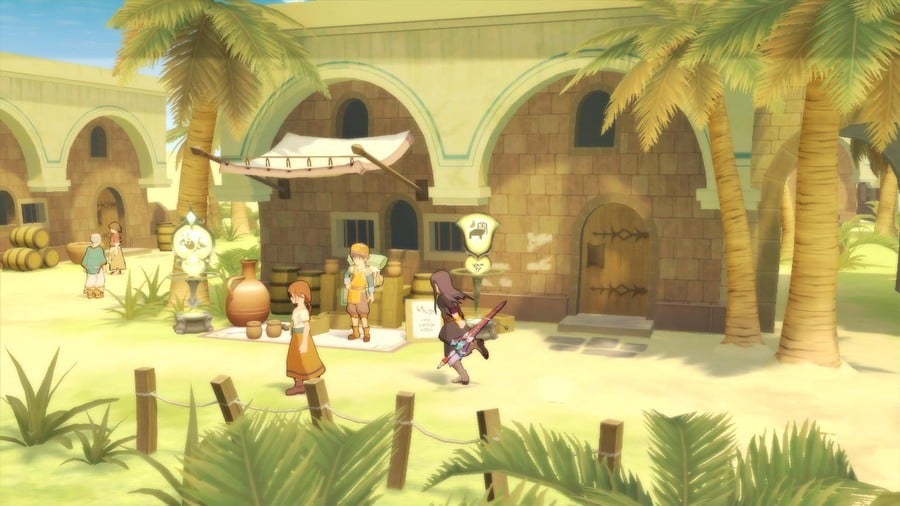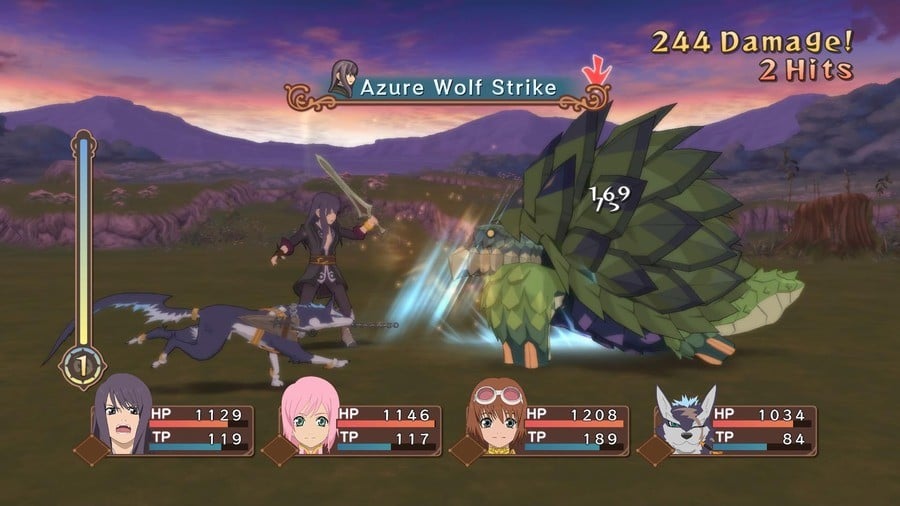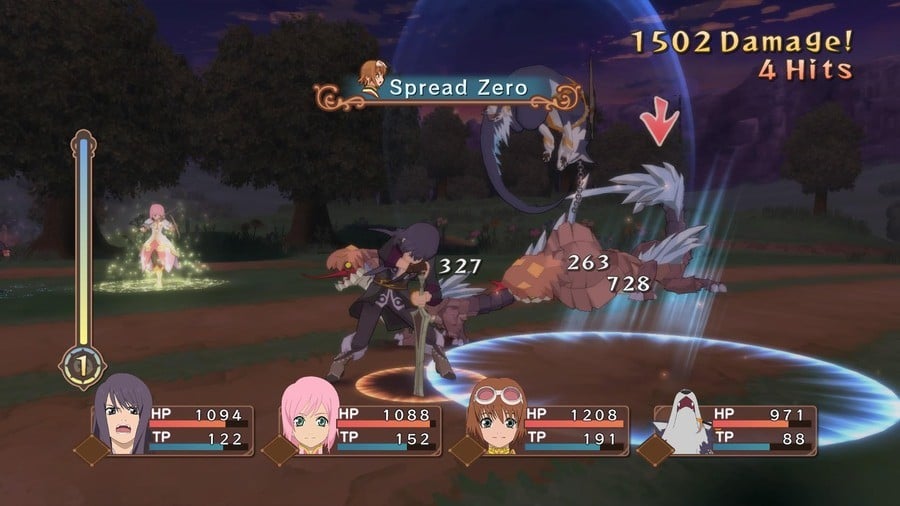
Tales of Vesperia: Definitive Edition can be a surprisingly difficult game to truly grasp. As a traditional Japanese role-playing title it's easy enough to get into, but exploring the depths of the combat system, for example, takes time and a lot of practice.
With this guide, though, the hope is that we can make the early hours of your adventure more manageable. Below, you'll find a number of tips and tricks that should help Yuri and the gang on their quest -- especially if you're totally new to the game.

Never forget to free run
This first tip is one of the most important. During battle, you'll notice that your character is locked to a line of vertical movement -- you can only move backwards away from the enemy, or forwards, towards the enemy. This helps keep you in place when attacking enemies and performing combos, but using only this kind of movement is a death sentence -- especially later in the game.
This is where free running comes in. By holding L2, you'll be able to move around the battlefield freely with the direction stick. Not only is free running ideal for moving away from an incoming attack, it's also perfect for positioning yourself behind or to the side of an enemy, opening them up to full combos.
In some situations, free running is pretty much your only option when it comes to defending yourself. Always, always, always consider making use of free running when you're low on health, or when a boss enemy is in a dangerous overlimit state. Free running can even be used to bait out attacks by dashing in close to your opponent before quickly moving away.
In short, free running, along with blocking, is a key defensive technique. But take note: while free running, you can only perform a single standard attack that can't be used to start combos. Remember to take your finger off L2 before going in for the kill.
Synthesis can be a great way to power up your party
Levelling up your party by winning battles and gaining experience is the most obvious way to strengthen your heroes, but it's powerful new equipment that often grants you the most noticeable stat boosts. You can buy weapons and armour from shops found in towns, but don't ignore the synthesis option.
Synthesising allows you to create weapons and armour by using up materials that are either found out in the world or are dropped by monsters that you defeat, and many pieces of equipment can only be obtained through synthesis.
It's a good idea to check out your synthesis list whenever you come across a new shop, as new weapon and armour recipes are added as you progress through the game. Oftentimes, the gear that you can synthesise will be better than the stuff that you can buy with your money, so if you think that the party could do with toughening up, synthesising should be your first port of call.
As mentioned, synthesis requires materials, and while basic materials are plentiful, some recipes may demand a different piece of equipment. As such, it's actually worth holding on to your old weapons and armour just in case you can use them to forge new gear later on.

Keep your healing and recovery items stocked up
Gald, the currency in Tales of Vesperia, is not hard to come by. Just through combat alone, you're going to acquire a small fortune, and there are items that can maximise the amount of gald that you're given. With that in mind, there's no point in being stingy.
Don't be afraid to spend your gald on all kinds of healing items. Keeping your inventory topped up is important during long dungeon runs, in which managing your TP can suddenly become a priority after a string of battles. Status conditions, like poisoning and paralysis, can also be a real pain, so likewise, carrying a batch of recovery items is highly recommended.
Search drawers, wardrobes, and boxes
Treasure chests are peppered rather liberally throughout Tales of Vesperia, but they're not the only way to get your hands on lovely loot. Sometimes, boxes, crates, drawers, cabinets, wardrobes, and weapon racks can be searched by walking over to them and hitting X. They look just like background objects, but they're always worth checking.
While the items that you find usually aren't as impressive as the ones you find inside of treasure chests, you do occasionally stumble across a rare weapon or very useful healing item. Again, worth it.
Use melee-based party members to distract enemies
Every playable character in Tales of Vesperia is capable of melee-based combat, but some are much better at it than others. Yuri, for example, is a swordsman through and through, so he'll almost always be toe-to-toe with his opponent. Meanwhile, although she has a sword and shield, Estelle has access to healing artes, meaning that she should probably keep her distance a lot of the time.
Keeping your enemies away from characters like Estelle and other long-range party members is a priority. Fortunately, doing so is simple, as enemies tend to close in on the characters closest to them, or characters who have attacked them. With this in mind, you can quite easily get an enemy or two to focus on Yuri or another melee-based fighter, keeping them occupied while your allies at the back cast their spells.
However, things can quickly take a turn for the worse if someone like Yuri becomes isolated and surrounded. As such, it's usually best to bring at least two melee-based characters into battle. That way, groups of enemies have a tendency to split up, allowing you to better manage the situation.

Coordinate your attacks with other party members
In Tales of Vesperia, all attacks stagger, allowing for combos. Hit an enemy with one attack and they'll be open to another, meaning that concentrated offence could be considered the best form of defence in most situations. And we're not even talking about advanced combos here -- we just mean that correctly timing even your most basic attack swings is the best way to keep an enemy locked down.
If an ally is busy smacking an enemy with their own attacks, let them get close to finishing their onslaught before you go diving in. By doing so, you'll keep the combo going, and in turn, you'll prevent the enemy from retaliating. Now, it can be a little tricky to properly coordinate with the artificial intelligence, but again, you don't have to pull off crazy combos -- all you need to do is keep the enemy pinned in place.
Tweak your formation and tactics
Buried in the main party menu are options to tweak both your party's formation and the artificial intelligence of your allies. If you're not quite happy with the way that combat is going, you should definitely take the time to explore this stuff.
Changing your formation may not seem like a huge deal, but doing so can drastically alter the opening moments of a battle. The default positions of each party member are mostly fine, but with a little tinkering, you can make Yuri and the gang more effective based on your style of play.
For example, you may find that because of his advanced positioning, Yuri often draws the attention of multiple enemies right at the start of combat. Before you know it, he's surrounded and taking hits -- but you can easily stop this from becoming a regular occurrence. Head into the formation menu and move his character icon back a little, or place another character by his side to divide the enemy's attention.
Likewise, if you're working your way through a dungeon and your allies are constantly running low on TP, you may want to head to the tactics screen and make changes to their behaviour. You can lower their arte usage, or you can tell them to stop using artes once their TP drops below a certain threshold. You can even plan out a number of different tactical setups and change between them during combat.

Give your new artes a try
This one may seem a bit obvious, but it's surprisingly easy to ignore newly learned artes in favour of sticking with your tried and tested attacks. As characters level up, they learn more and more artes. Naturally, some are better than others, but the only way that you're going to know is if you test them out in combat. And no, just reading their description doesn't always give you the right impression.
You never know, you might just find a new favourite.
Stuck? Try easy mode
Tales of Vesperia: Definitive Edition has three difficulty modes: easy, normal, and hard. On normal the game's not too difficult once you know what you're doing, but during the early hours, boss fights in particular can present a challenge.
If you're having trouble, remember that you can change the difficulty at any point outside of combat. Easy mode greatly reduces the damage that enemies inflict upon you and your party, boosting your chances considerably. As such, it's also well worth a look if you're here primarily for the story, or if you don't feel like doing too much grinding.
There is one catch to easy mode, though, in that you aren't awarded any grade after battle. Grade is a hidden currency that can be used in New Game +. With it, you can purchase modifiers for your next playthrough, but if you've played through the game on easy mode, then you won't have any grade saved up.
Do you have any tips or tricks for Tales of Vesperia: Definitive Edition? Share your knowledge in the comments section below.





Comments 4
You forgot the most important thing always take the time to explore backtrack and to talk to everyone in a town to find missable side quests and events to earn titles and other items
thank you for this list!
i always appreciate these guides you guys make.
Thank you so much for the tips. Looking forward to starting this game tomorrow morning.
@shogunrok Hey man thanks for the warning. I just started this game an hour ago on Switch, it of the horrible Joycon controllers, and I think I'm going to change over to easy mode b/c I almost died during the world's stupidest tutorial battle where they tell you what buttons to use but then don't actually let you fight, the baddies just fall down and say ouch. Then you start fighting and they kick your butt. I survived w/ 27 health left, fight starts at 550, and I had to use 2 healing items. Whenever I tried to use an Artes it just opened up the menu, possible I had no TP, who knows, instructions suck.
Anyway thanks for the heads up, I know you guys hate 3 yr old replies but it was either this or hunt you down on Twitter.
Tap here to load 4 comments
Leave A Comment
Hold on there, you need to login to post a comment...